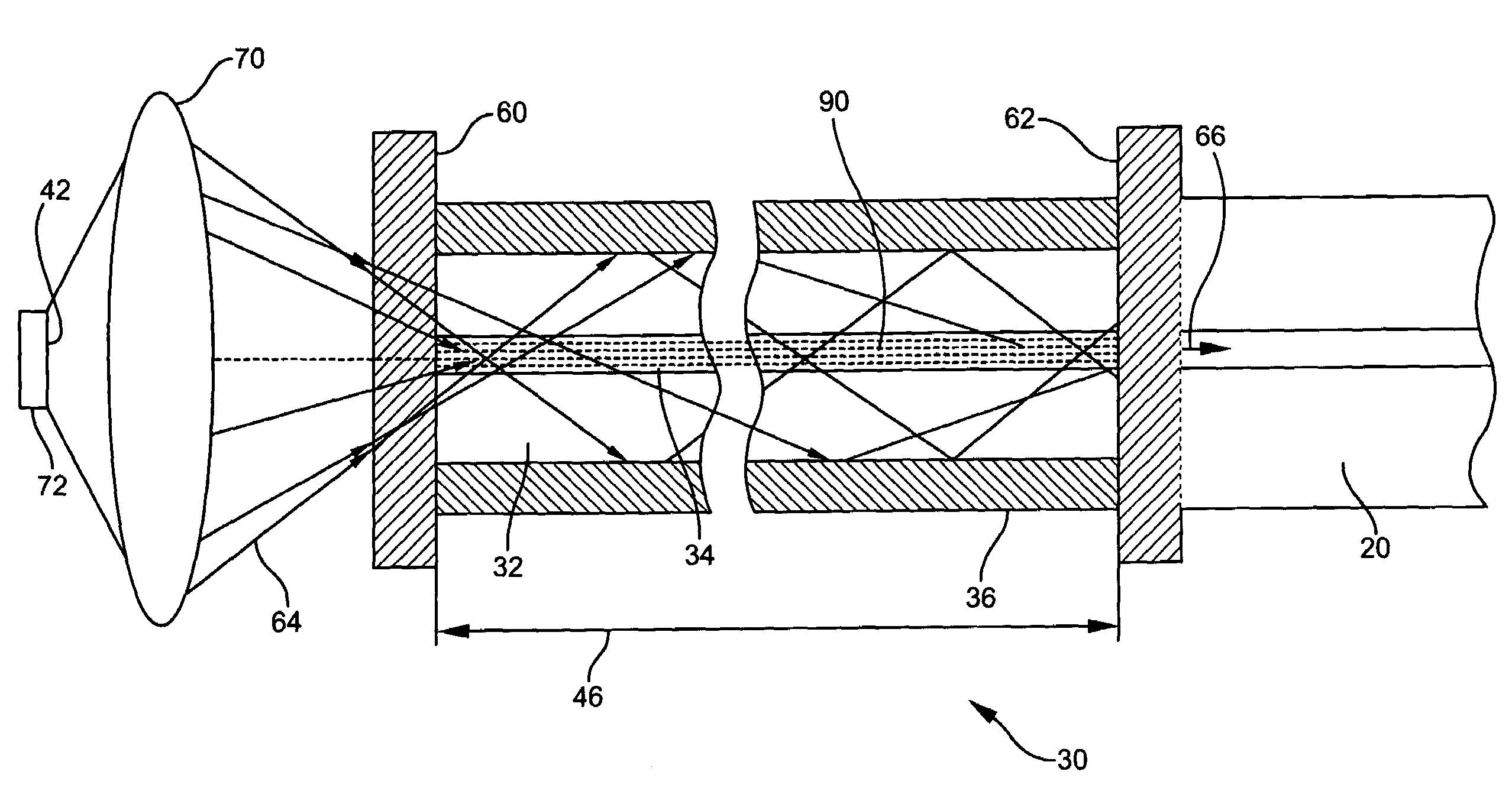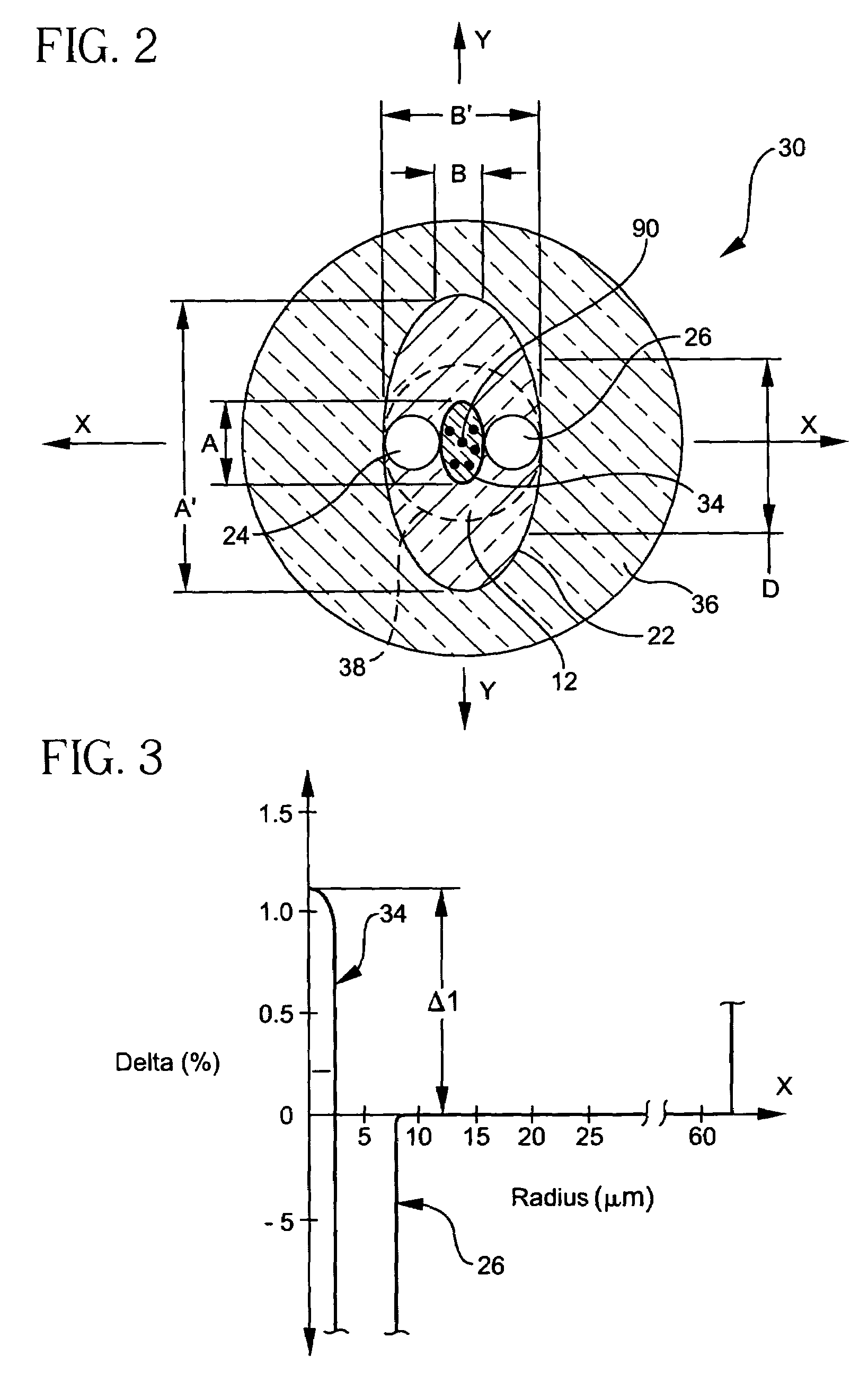Single polarization optical fiber laser and amplifier
- Summary
- Abstract
- Description
- Claims
- Application Information
AI Technical Summary
Benefits of technology
Problems solved by technology
Method used
Image
Examples
experimental example 1
[0118]A first representative single polarization fiber 30 according to the invention was manufactured having the cross-sectional structure shown in FIG. 7. The fiber 30 has a central core 34 having an average diameter, d avg, of about 5.33 microns, a maximum dimension, A, of about 7.75 microns, a minimum dimension, B, of about 2.9 microns—resulting in a first aspect ratio A / B equal to about 2.7, a central core delta, Δ1, of 1.1%, and an alpha profile having an α of about 2. The holes 24, 26 were partially included in the annular region 12 and partially included in the cladding 22. Holes 24, 26 had an average diameter of about 8.3 microns. The annular region 12 was fluorine-doped thereby being depressed relative to the pure silica cladding 22. The relative refractive index, Δ2, of the annular region 12 was −0.4% and the outer diameter D of the annular region 12 was about 16 microns. The holes 24, 26, in this embodiment, substantially abutted the sides of the central core 34. The sing...
experimental example 2 and 3
[0119]Other portions of the same fiber along the length thereof (and spaced from the length of Exp. Ex. 1) were also tested in Exp. Ex. 2 and 3 giving slightly different performance results. It was determined by the inventors that this variation in properties along the length of the fiber was due predominantly to process control variations in the prototype fiber which in a production fiber would be in much better control.
experimental example 4
[0120]A further experimental sample is shown in Table 2 as Exp. Ex. 4. In this example, the core delta, Δ1, was 2.0% and Δ2, was −0.4%. In this example, the Aspect Ratio, AR1, was about 3.2 having an average core diameter, d avg, of about 4 microns ({A+B} / 2). Average hole diameters and other fiber parameters were similar to example 1. As is demonstrated by this example, raising the relative refractive index of the central core to 2.0% has increased the Single Polarization (SP) bandwidth to 42 nm as compared to 1.1%.
[0121]The optical properties of the single polarization fiber described above and additional experimental fibers are given in Table 2.
[0122]
TABLE 2Optical Properties For Experimental Example FibersExample #Exp. Ex. 1Exp. Ex. 2Exp. Ex. 3Exp. Ex. 4Extinction Ratio ER (dB)152220>15in the SPBBeat Length LB (mm)4.213.892.791.11Attenuation (dB / m)0.027——1.76P1 Cutoff λ1 (nm)115711471164972P2 Cutoff λ2 (nm)1183117510971014SP Band Bandwidth (nm)26283342
[0123]Referring to FIG. 6, a...
PUM
| Property | Measurement | Unit |
|---|---|---|
| Length | aaaaa | aaaaa |
| Length | aaaaa | aaaaa |
| Sound / signal amplitude | aaaaa | aaaaa |
Abstract
Description
Claims
Application Information
 Login to View More
Login to View More - R&D
- Intellectual Property
- Life Sciences
- Materials
- Tech Scout
- Unparalleled Data Quality
- Higher Quality Content
- 60% Fewer Hallucinations
Browse by: Latest US Patents, China's latest patents, Technical Efficacy Thesaurus, Application Domain, Technology Topic, Popular Technical Reports.
© 2025 PatSnap. All rights reserved.Legal|Privacy policy|Modern Slavery Act Transparency Statement|Sitemap|About US| Contact US: help@patsnap.com



